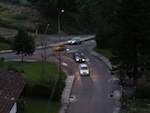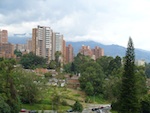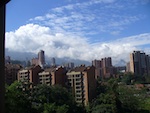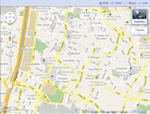Editorial Note: In April, I took a month off in Medellin. For me, this meant an interesting and diverting month. For you, this means 30 days of posts about my vacation. I’ll try to make them somewhat amusing.
Colombia is not a county that’s particularly awash in credit. Real estate, for instance, is often an all-cash deal. On the smaller scale, cell plans have historically been of the pre-paid (prepago … also a slang term for a woman of negotiable virtue) variety.
Tarjetas
Here’s how everyone (outside Colombia) tells you that Colombian cell plans work: You buy your phone/SIM card which comes with an initial balance. You use up that balance as you send text messages and make phone calls. (On the Colombian cell systems, all costs are always borne by the caller.) When the balance gets low/zeros out, you supposedly buy a gift-card-like thing at, for instance, a supermarket, and recharge the phone’s balance by keying in a number from the card.
This is a dirty, stinking, lie. If you believe it, you’re going to waste a lot of time looking for the cards, which don’t seem to exist anymore. The new system works like this: You go to a “recharge point” (i.e., a grocery store cashier), give them your phone number, and ask them to credit your balance. Then they push a bunch of buttons, your phone makes a noise and … you’re supposed to do something, and then you’re good to go.
Cliffhanger
Yesterday, I wrote about the sinking feeling one gets when actual communication — off-script communication — becomes necessary in a foreign language on which one has only a shaky grasp. Well, let me tell you a little story about that.
After much hemming and hawing, I’d been able to work out the new system outlined in the preceding section. The next time I went shopping, I readied myself to ask the cashier to add some credits to my cellphone. At first, things went well. I made my request, she understood it, I handed over a slip of paper with the number on it (hey … you try rattling off a 10-digit number in a foreign language under time pressure without screwing it up), she asked me how much to add, I told her, she keyed in something, my phone buzzed, and … she said something and looked at me expectantly.
About this time I noticed that half the population of Medellin had materialized in line behind me. At the only open register. #^@*!!
The situation was hopeless. I had no idea what she wanted. I tried to wave off the transaction … to indicate that I didn’t care whether the transaction went through, that I didn’t care about the money, that I just wanted to forget the whole thing, pay for the rest of my purchases and move on with my life (and stop holding up the line of what were, under the circumstances, remarkably patient Colombians).
No dice. Ultimately, some manager type was fetched with a manager-type-key that was used, I presume, to back out the transaction. Rarely have I felt so uncomfortable.
Travel. It ain’t all gravy.
The Future
For those of you planning a trip to Colombia, some speculation about the future of Colombian cell plans. I get the feeling that the cell companies are moving more and more towards a post-paid convention; aside from plans explicitly structured along these lines, they seem to be making it easier and easier to recharge your balance by linking directly to your (Colombian) bank account. So, if you travel here in the next few years, you might find that the system has changed from what I described in this post. (The new system might be more or less friendly to the traveler, depending on what it is.)
 I don’t want to say that Colombians are, as a people, reckless drivers, but I will say that you see a lot of this sort of thing:
I don’t want to say that Colombians are, as a people, reckless drivers, but I will say that you see a lot of this sort of thing:




